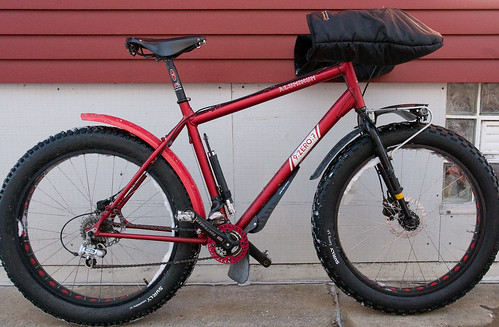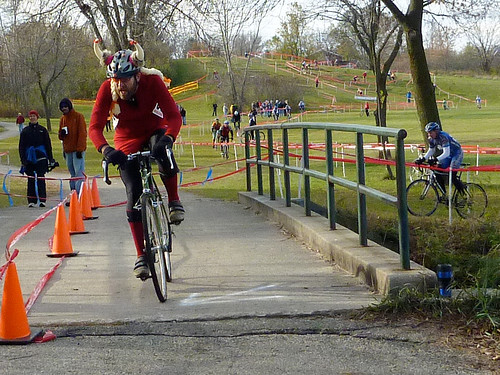New Bike
The 9:Zero:7 snow bike from Chain Reaction Cycles in Anchorage is a close relative of the Surly Pugsley. The low-pressure, high-floatation tires make a huge difference in soft snow. It can't just go anywhere, but it can go plenty of places that regular bikes can't. Very useful in the hilly early part of the race. Less useful on the paved segments.

This bike was a big improvement over the Black Pony's 26"x2.5 tires on 47mm rims. It holds a line on the mushy stuff where skinny tires just can't. The aluminum frame and single-wall rims make it substantially lighter than a Pugsley or Salsa Mukluk.
Clothing
I had obviously overdressed the first two years I did the Triple D, and for most of the training rides leading up to them. Big hat tip to Blogger member Jack London for posting in the comments this link to an article on PsychoVertical about how to dress for exertion in the cold. The outfit went as follows:
- Head: Giro G10 snowsport helmet (previously mentioned here) and homemade lightweight fleece face mask. Serfas Sike-Out sunglasses and generic clear safety glasses.
The helmet scores points for ear protection but loses some for being heavy and sometimes too warm. The glasses performed well except that my eyes dried out toward the end of the race. The search for a better pair of goggles resumes.
- Torso: Under Armour Cold Gear 2.0 base layer and Mountain Hardwear Transition Super Power Jacket. (Please note that I don't name this stuff.)
That's it. Both skin-tight...I normally wear a medium now, but the UA base was a small. I did get a little damp, especially early on, but changed into second base layer and added North Face arm warmers for the return trip. The jacket has some Windstopper material on it, and it really is properly named.
- Lower body: Windfront briefs and strategically-placed wool sock; padded cycling shorts, Polar fleece tights and Nashbar C-Pant knickers.
No complaints.
- Feet: Two pairs of thin wool socks, Lake MXZ-302 winter cycling shoes (also mentioned here) and Planet Bike Dasher shoe covers.
Feet stayed remarkably warm. One brief chill in hour 6 that went away after a brief jog. The Dashers are nice in that they are large enough to fit over the boots and give me about 10 more degrees of temperature, but too bad they aren't very durable.
Toasty.
Nutrition
Experimented with a number of things during the off-season and after reading Matt Fitzgerald's book Racing Weight settled on Accelerade as my primary "food." I really like the orange in spite of a strong dislike for the other flavors. I took two 24-ounce Polar insulated bottles of this inside my frame bag, with a chemical warmer to keep it from freezing. Remixed one of the bottles at the halfway point. Drank all of it, in addition to at least 80 ounces of plain water from my Camelbak hydration pack. (My advice? Stick the bite valve between the pack and your back to keep it from freezing or thaw it if it does freeze. Yes, this really works, even if people tell you it won't, which they will.)
I also ate some real food. Eight whole wheat fig bars, some almonds, a couple of christmas cookies, a banana and a few Peanut M&Ms. Some more non-foods too—3 Gu gels.
Before the race, I had about 400 calories worth of steel-cut oats, two eggs, some breakfast potatoes, toast, a banana, coffee and Nuun electrolyte drink.
Fitness and Training
I took two sessions of a class called Functional Strength Training for Cyclists from the UW Sports Medicine Fitness Center. There is exactly zero time on a bike in this class, but a big emphasis on leg, core and upper body strength and on improving balance. Most of the exercises used body weight, spine ball or medicine ball, resistance bands or small free weights. Felt real improvement by the end of the second session.
Improved strength and dropping my weight down to about 165 on race day really helped me keep moving, especially on hills.
Also rode a lot this year, including 50+ mile rides on each of the three weekends leading up to the race. Pace and endurance have both steadily improved over the last 3 years. Oh, and there was some cyclocross racing too. Helps a little with peak efforts, mounts and dismounts, but placement shall go unmentioned.

Race Strategy
Having never really been a racer, this is one thing I need to work on. The experience from this year certainly seemed to help. Still, it seems like it takes a lot of discipline to make good decisions in the heat of the moment. This went better this time than in years past, but could still use a little work.
Guess I'll just have to put in more miles...
Other Triple D posts: Race summary; race report part 1 and part 2.

1 comment:
Nice review
Post a Comment